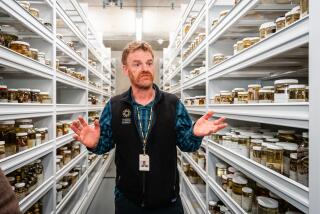In Florida’s Everglades, hundreds of snake hunters aim to bag pythons

- Share via
reporting from BIG CYPRESS NATIONAL PRESERVE, Fla. — The big snake was sunning itself on a rock when Jim Sweeney pinned it with his snake hook and grabbed it around the middle.
It was, unfortunately, a yellow rat snake, not a Burmese python. After holding it for a few seconds as it writhed in his hands, Sweeney returned the irritated reptile to its rock and resumed his hunt for the giant constrictors that have infested the Everglades.
The 2016 Python Challenge opened Saturday, as individuals and teams headed into the wilderness to try to thin south Florida’s population of Burmese pythons and win prizes of up to $1,500 for catching the most or the longest. An unwelcome byproduct of the exotic pet trade, the snakes from southern Asia have infested the Everglades since at least the 1990s, chowing down on native wildlife and competing with predators such as alligators and panthers.
Sweeney, 56, his nephew Michael Paen, 23, and his friend Michael Mele, 46, all of Plantation, Fla., formed what they optimistically named the Dream Team. Having caught snakes in South Florida since he was a child, even assisting biologists as a volunteer at Everglades National Park, Sweeney knew where to look. The group headed to the eastern section of Big Cypress National Preserve, a swampy area littered with boulders that made perfect sun decks for warmth-loving snakes.
“We’re participating in the 2016 Python Challenge to remove any Burmese pythons that are really causing a lot of damage to the native wildlife,” said Sweeney, a building contractor. “So we hope to find a few and get rid of them and get in the hunt for the big money.”
Equipped with snake bags, hooks, machetes and rubber boots, the trio scrambled over boulders and waded through knee-deep water, watching for a flash of the python’s distinctive skin pattern. As the day grew hotter, they shifted the search to shady areas. They picked their way through a hunting camp, looking under pieces of wood. They pulled back the leaves of palmetto bushes and small trees.
As they trudged down a pitted road next to a lake, a man in a goatee drove up in a green homemade swamp buggy made from tractor wheels mounted on the frame of a 1978 Chevrolet Blazer. The driver, Michael Brady, had been out fishing. As a resident of Big Cypress, he knew all about the pythons, having used a pistol or shotgun to kill what he estimates are eight to 10 of them, including one that he said was 14 feet long.
“I’m a hunter, and they are killing everything off,” he said. “‘Coons, possums, rabbits — anything that’s small. They’re getting deer too.”
But if he had seen his share of pythons, the members of the Dream Team did not. By midafternoon, they were giving up on that section of Big Cypress and heading back to their truck, their snake bags empty.
“I’m surprised we didn’t see any because we were in prime habitat,” Sweeney said. “I’m a little disappointed we didn’t see any.”
But he wasn’t giving up. He and the members of his team were making plans to hit some of the roads through Big Cypress, where they hoped to find the big snakes sunning themselves.
There appears to be less interest this year than in the previous challenge, held in 2013, when nearly 1,600 participants registered. This time, as of Friday, 628 people were registered.
It’s unclear whether the monthlong python hunt will have much effect. The last hunt resulted in the capture of 68 snakes. No one knows how many there are in the Everglades, but estimates run into the tens of thousands, and no one thinks the haul from the last challenge took much of a toll on the python population.
Follow @DavidFleshler on Twitter
ALSO:
A behind-the-scenes look at a Rams’ proposal the NFL couldn’t refuse
Explosion risk stalls plan to capture and burn gas from Porter Ranch leak
Her lead all but gone in Iowa, Hillary Clinton deploys Bill to win over voters
More to Read
Sign up for Essential California
The most important California stories and recommendations in your inbox every morning.
You may occasionally receive promotional content from the Los Angeles Times.










